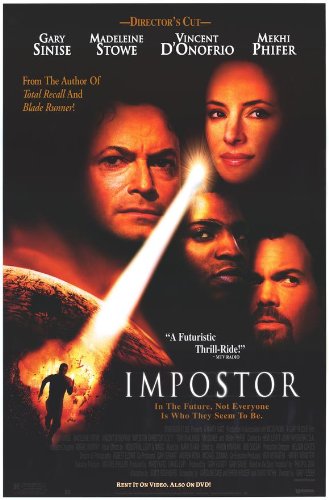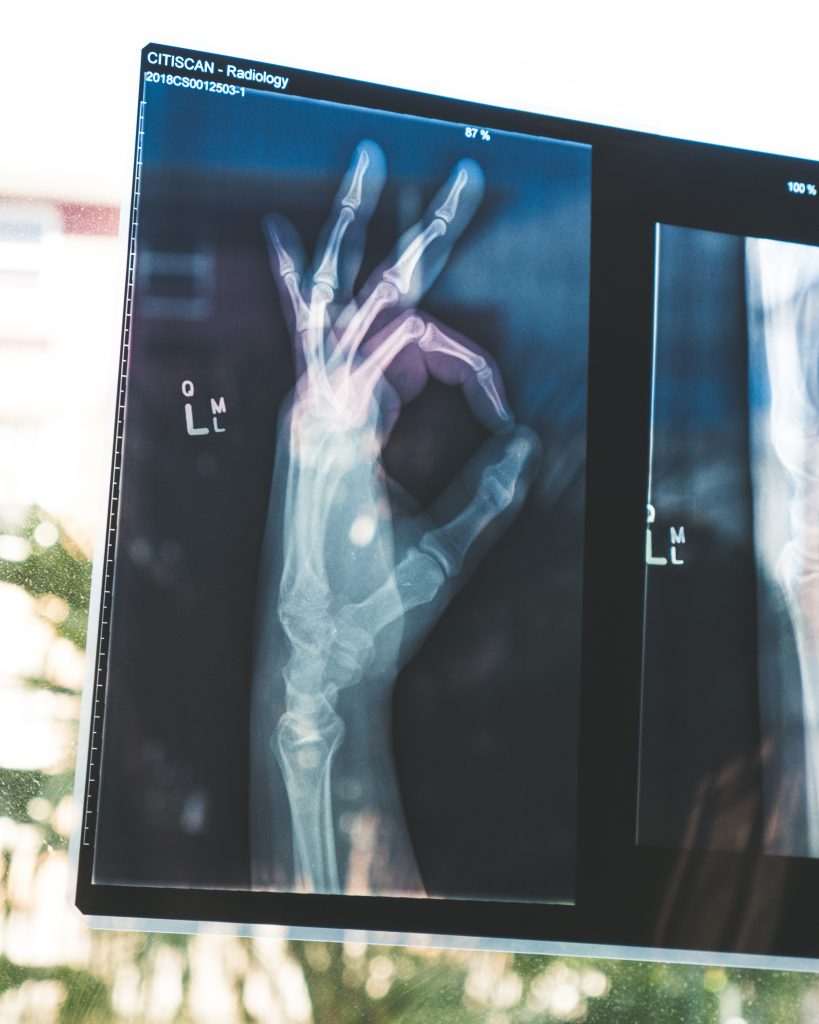Welcome back to our blog series “Have You Watched a Good Book Lately?”
The series’ intention is to track a number of books’ progression from the printed page to the silver screen and assess how well or how badly the filmmakers accomplished each of the adaptations.

Today we’re going to be discussing “Imposter,” yet another Philip K. Dick short story that was turned into a movie. The story was first published in Astounding in June 1953 and was adapted for the screen – both as a short and as a feature film – in 2001 by Scott Rosenberg, with the screenplay written by Caroline Case, Ehren Kruger, and David Twohy, and was directed by Gary Fleder, known primarily for his work on TV series and TV movies. For those of you unfamiliar with the basic premise, here is a brief synopsis of the short story (taken from Google) and the film (taken from imdb.com):
“Spencer Olham (Gary Sinise) had a perfect life: a loving family and a beautiful wife (Madeleine Stowe). On Tuesday evening he went to bed an acclaimed and well-respected scientist. On Wednesday morning, he woke up public enemy number-one. Now Spencer has to do everything in his power to prove his innocence in a future where nothing is as it seems and paranoia is everywhere.”
“In the future, an alien race uses androids as bombs to attack Earth. A government weapons specialist is accused of being one such android and sets out to prove his innocence.”

How true is the film to the source material?
From the Source’s Mouth
Let’s start our discussion with one of the main concerns of any story adaptation – how true is the film to the source material? Despite the fact that the original story was only about 10 pages long and that the filmmakers therefore had to do a lot of padding to get the film to its 1 ¾-hour run time, the two versions are remarkably similar.
The Outspacers arrived some time ago from Alpha Centauri, their needle-ships relentlessly blasting their way to Earth. It wasn’t until Westinghouse Labs developed a protect-bubble to cover the entire planet that humans had any kind of defense. Spencer Olham works for “the Project,” building a positive combat weapon. He is tired, though – tired of the war, tired of the work. All he wants is to take a vacation, maybe in Sutton Wood, where he and his wife Mary had camped one time. But when he mentions this to Mary, she says, “The Wood was burned a few weeks ago. I thought you knew. Some kind of flash fire.”
He doesn’t have much time to think about it as his friend and co-worker Nelson arrives to pick him up. There’s someone else in the car, a Major Peters, whom Olham doesn’t know. “No, I’m not with the Project,” he tells Olham, “but I know something about what you’re doing. My own work is altogether different. … I’m with the government. With FSA, the security organ. I’m here to arrest you as an Outspace spy.” Nelson drives the business end of a gun in Olham’s ribs. “I think we should kill him now. We can’t wait.” But Peters wants to question Olham, who is completely dazed by this turn of events.

Nelson drives the business end of a gun in Olham’s ribs.
When they land on the Moon’s farside, Peters tells Olham, he will be turned over to a group of men who will destroy his body. Still uncomprehending, Peters finally explains. “Two days ago we received a report that an Outspace ship had penetrated the protect-bubble. The ship let off a spy in the form of a humanoid robot. The robot was to destroy a particular human being and take his place. Inside the robot was a U-Bomb. The robot would live the life of the person he killed, entering into his usual activities, his job, his social life. He had been constructed to resemble that person. No one would know the difference.”
Olham adamantly asserts that he is the real Spencer Olham, that the robot never reached him. Surely, there must be some medical test that will prove his identity, or maybe they can find the crashed ship. Peters won’t listen. “The robot,” he says, “would become Olham in mind as well as body. He was given an artificial memory system, false recall. He would look like him, have his memories, his thoughts and interests, perform his job. But there would be one difference. Inside the robot is a U-Bomb, ready to explode at the trigger phrase.” The Moon is isolated enough that the bomb couldn’t do much damage if it was set off in the disassembly process.
Olham knows he needs to get back to Earth – Mary could prove his identity if he could get word to her. He tricks Peters and Nelson into leaving the craft, turns it around and heads back home. The moment he reaches Earth, he calls Mary, asking her to get a doctor with access to an X-ray, fluoroscope, or some other equipment that would use facts to prove his innocence not kill him with conjecture. When he gets to the house, Mary answers the door, but he can see in her face that “they” have reached her, and he races away back toward his ship. Peters, however, has returned from the Moon and is waiting there, calling into the darkness, “If you don’t come out, we’ll catch you. It will be only a matter of time. You will be destroyed on sight, and we will have to take the chance that the bomb will detonate. The whole county is being searched, inch by inch. There is no place you can go.”

He calls Mary, asking her to get a doctor with access to an X-ray
Olham knows he’s right, but his mind still races through possibilities. Somewhere, he knows, there must be the crashed remains of the needle-ship, and, within it, the destroyed robot. It would be near the Project’s location, so the robot could easily reach it, but it wouldn’t be obvious. Suddenly it hits him – Sutton Wood, which Mary told him burned down from an unexplained fire. One peak in the Wood sticks up unexpectedly; any ship unfamiliar with the terrain would undoubtedly run into it. The needle-ship must be there. He hears the posse closing in around him as he makes his way further down the hill. Peters is the first to emerge, gun drawn, but Olham stops him, shouting, “It’s down there. You’ll find the remains of the robot in the ship. Look, will you?” Peters hesitates a moment then orders two men to take a look before following himself.
The needle-ship is there, and something lies beside it. “On the ground, bent and twisted in a strange shape, was a grotesque form. It looked human, perhaps; except that it was bent so strangely, the arms and legs flung off in all directions. The mouth was open; the eyes stared glassily.” “Like a Machine that’s run down,” Peters murmured. “I can’t believe it. You were telling the truth all the time.”
Nelson, though, won’t let go. He heads over to the body and reaches into it, grabbing hold of a metal object. It’s an Outspace needle-knife, covered with blood. He looks at Olham. “You killed him with this and left him beside the ship.” Olham begins to tremble, and his thoughts race. “But if that’s Olham, then I must be –“
The blast was visible all the way to Alpha Centauri.

The blast was visible all the way to Alpha Centauri.
And so we come to the film, which is basically the same story, only updated to take into account modern technology and sensibilities. Spencer Olham is a brilliant subatomic physicist and special weapons researcher married to Maya, a doctor aboard the space station where he works. This particular morning, building security flags Spencer for a voiceprint ID, while it lets Nelson through without one. He thinks little of it while they examine the “superweapon” they’ve developed that’s almost ready to go. Olham questions the use of such a devastating weapon, but a Major Hathaway who stands watching them says the weapon “is a godsend. It will ensure the preservation of the human race.” He then introduces himself, telling them he works with enemy infiltration, and before they know it, he injects Spencer with some industrial-strength truth serum and carts him away for interrogation. The next thing Spencer knows, he’s strapped to a chair with electrodes plastered all over him. A whole gallery of people, including Nelson, stand watching while he’s told he’s an alien infiltrator with a U-Bomb implanted in his heart, and is pressed to explain the existence of god, something a “soulless” creature couldn’t do.
As Hathaway’s men move him from the chair to the device that will rip open his heart and expose the bomb, Spencer makes his move, grabbing a gun and securing a hostage. Hathaway doesn’t blink twice but shoots the hostage multiple times to get at Spencer, who manages to escape in the confusion. He travels through the station’s maze of tunnels, eventually ending up in the “Dead Zone,” a desolate area now home mostly to refugees and the poor. Hathaway tracks him every step of his way through Zone with the aid of Spencer’s “sim coat,” an implanted device read by special scanners strategically placed to keep track of people’s whereabouts and determine access to various parts of the station. It’s hard for him to stay even one step ahead of the Major, and it doesn’t help that he’s prone to sudden fits of hallucinations from the drugs that leave him dazed and disoriented. Spencer’s fortunes turn somewhat when he’s captured by a group of rebels living in the Zone. He convinces one of them – Cale – to help him get across the border and into the city in exchange for needed medical supplies from Maya’s hospital. The rebels remove his sim coat, and Cale takes him into the city, where they breach the hospital.

Into the city in exchange for needed medical supplies from Maya’s hospital.
Spencer’s reason for getting to the hospital is that it holds the proof he needs to prove his identity, and his innocence. Three years before, doctors had done a molecular core PET scan on him; if they take another one now, they should be able to match the data. He recovers his old data and forces one of the doctors, at gunpoint, to perform the test again. However, the doctor alerts security, soldiers swarm the lab, and the scan remains incomplete – it shows most of Spencer’s lower body, but it doesn’t show the heart, where the bomb supposedly resides. Hightailing it out of the facility, Spencer risks contacting Maya, telling her they need to meet. She doesn’t know whether to believe him or not, but she agrees to meet him. The Major follows her, though, and the two run toward Sutton Wood, where Spencer has told her the crashed ship – and the dead pilot – should be. They make it to the ship, but Hathaway is right on his heels, and soon the two of them are surrounded by armed men.
Spencer tries to make his case again, but Hathaway surprisingly says he believes him, although he doesn’t lower his weapon. “We’ve decoded more of the list,” he tells Spencer, then orders him to move away from the ship and from Maya. He was the connection to the Project’s secrets for the Centauri, but Maya is the impostor. Spencer rips opens the needle-ship’s cabin, only to find Maya’s body inside. Maya tries to run, but the soldiers gun her down. Spencer is distraught over the loss of his “salvation,” but he’s in for a worse shock than that. One of the soldiers finds another ship and opens its cabin, and, within, lies the body of Spencer Olham. The explosion, we hear a reporter mentioning later, took tens of thousands of lives and decimated the station.
Non-Standard Deviations
Other than the use of more modern technology and the double-surprise ending, the movie did not deviate much from the original story. That can be good thing, if all you want is a copy, but it can also be something of a disappointment if you wanted something more. I imagine each version will have its fans and its detractors, depending on what they hoped to get out of the experience, and that’s okay.

The Final Cut
So, how did “Impostor” as a movie fare as a short story adaptation overall? It was certainly very visual, as a film should be, and the acting was good, which helped develop the characters as if they were real people. I’d give it a B+.
What do you think? Do you agree? Disagree? Please add your comments in the section below.
– Miriam Ruff, Content Creator, PoetsIN
DISCLAIMER: The opinions discussed in this blog post are solely those of the blogger and do not necessarily represent any thoughts, values, or opinions of PoetsIN and any of its affiliate groups.
Please follow and like us:
Welcome back to our blog series “Have You Watched a Good Book Lately?”
The series’ intention is to track a number of books’ progression from the printed page to the silver screen and assess how well or how badly the filmmakers accomplished each of the adaptations.
Today we’re going to be discussing “Imposter,” yet another Philip K. Dick short story that was turned into a movie. The story was first published in Astounding in June 1953 and was adapted for the screen – both as a short and as a feature film – in 2001 by Scott Rosenberg, with the screenplay written by Caroline Case, Ehren Kruger, and David Twohy, and was directed by Gary Fleder, known primarily for his work on TV series and TV movies. For those of you unfamiliar with the basic premise, here is a brief synopsis of the short story (taken from Google) and the film (taken from imdb.com):
“Spencer Olham (Gary Sinise) had a perfect life: a loving family and a beautiful wife (Madeleine Stowe). On Tuesday evening he went to bed an acclaimed and well-respected scientist. On Wednesday morning, he woke up public enemy number-one. Now Spencer has to do everything in his power to prove his innocence in a future where nothing is as it seems and paranoia is everywhere.”
“In the future, an alien race uses androids as bombs to attack Earth. A government weapons specialist is accused of being one such android and sets out to prove his innocence.”
How true is the film to the source material?
From the Source’s Mouth
Let’s start our discussion with one of the main concerns of any story adaptation – how true is the film to the source material? Despite the fact that the original story was only about 10 pages long and that the filmmakers therefore had to do a lot of padding to get the film to its 1 ¾-hour run time, the two versions are remarkably similar.
The Outspacers arrived some time ago from Alpha Centauri, their needle-ships relentlessly blasting their way to Earth. It wasn’t until Westinghouse Labs developed a protect-bubble to cover the entire planet that humans had any kind of defense. Spencer Olham works for “the Project,” building a positive combat weapon. He is tired, though – tired of the war, tired of the work. All he wants is to take a vacation, maybe in Sutton Wood, where he and his wife Mary had camped one time. But when he mentions this to Mary, she says, “The Wood was burned a few weeks ago. I thought you knew. Some kind of flash fire.”
He doesn’t have much time to think about it as his friend and co-worker Nelson arrives to pick him up. There’s someone else in the car, a Major Peters, whom Olham doesn’t know. “No, I’m not with the Project,” he tells Olham, “but I know something about what you’re doing. My own work is altogether different. … I’m with the government. With FSA, the security organ. I’m here to arrest you as an Outspace spy.” Nelson drives the business end of a gun in Olham’s ribs. “I think we should kill him now. We can’t wait.” But Peters wants to question Olham, who is completely dazed by this turn of events.
Nelson drives the business end of a gun in Olham’s ribs.
When they land on the Moon’s farside, Peters tells Olham, he will be turned over to a group of men who will destroy his body. Still uncomprehending, Peters finally explains. “Two days ago we received a report that an Outspace ship had penetrated the protect-bubble. The ship let off a spy in the form of a humanoid robot. The robot was to destroy a particular human being and take his place. Inside the robot was a U-Bomb. The robot would live the life of the person he killed, entering into his usual activities, his job, his social life. He had been constructed to resemble that person. No one would know the difference.”
Olham adamantly asserts that he is the real Spencer Olham, that the robot never reached him. Surely, there must be some medical test that will prove his identity, or maybe they can find the crashed ship. Peters won’t listen. “The robot,” he says, “would become Olham in mind as well as body. He was given an artificial memory system, false recall. He would look like him, have his memories, his thoughts and interests, perform his job. But there would be one difference. Inside the robot is a U-Bomb, ready to explode at the trigger phrase.” The Moon is isolated enough that the bomb couldn’t do much damage if it was set off in the disassembly process.
Olham knows he needs to get back to Earth – Mary could prove his identity if he could get word to her. He tricks Peters and Nelson into leaving the craft, turns it around and heads back home. The moment he reaches Earth, he calls Mary, asking her to get a doctor with access to an X-ray, fluoroscope, or some other equipment that would use facts to prove his innocence not kill him with conjecture. When he gets to the house, Mary answers the door, but he can see in her face that “they” have reached her, and he races away back toward his ship. Peters, however, has returned from the Moon and is waiting there, calling into the darkness, “If you don’t come out, we’ll catch you. It will be only a matter of time. You will be destroyed on sight, and we will have to take the chance that the bomb will detonate. The whole county is being searched, inch by inch. There is no place you can go.”
He calls Mary, asking her to get a doctor with access to an X-ray
Olham knows he’s right, but his mind still races through possibilities. Somewhere, he knows, there must be the crashed remains of the needle-ship, and, within it, the destroyed robot. It would be near the Project’s location, so the robot could easily reach it, but it wouldn’t be obvious. Suddenly it hits him – Sutton Wood, which Mary told him burned down from an unexplained fire. One peak in the Wood sticks up unexpectedly; any ship unfamiliar with the terrain would undoubtedly run into it. The needle-ship must be there. He hears the posse closing in around him as he makes his way further down the hill. Peters is the first to emerge, gun drawn, but Olham stops him, shouting, “It’s down there. You’ll find the remains of the robot in the ship. Look, will you?” Peters hesitates a moment then orders two men to take a look before following himself.
The needle-ship is there, and something lies beside it. “On the ground, bent and twisted in a strange shape, was a grotesque form. It looked human, perhaps; except that it was bent so strangely, the arms and legs flung off in all directions. The mouth was open; the eyes stared glassily.” “Like a Machine that’s run down,” Peters murmured. “I can’t believe it. You were telling the truth all the time.”
Nelson, though, won’t let go. He heads over to the body and reaches into it, grabbing hold of a metal object. It’s an Outspace needle-knife, covered with blood. He looks at Olham. “You killed him with this and left him beside the ship.” Olham begins to tremble, and his thoughts race. “But if that’s Olham, then I must be –“
The blast was visible all the way to Alpha Centauri.
The blast was visible all the way to Alpha Centauri.
And so we come to the film, which is basically the same story, only updated to take into account modern technology and sensibilities. Spencer Olham is a brilliant subatomic physicist and special weapons researcher married to Maya, a doctor aboard the space station where he works. This particular morning, building security flags Spencer for a voiceprint ID, while it lets Nelson through without one. He thinks little of it while they examine the “superweapon” they’ve developed that’s almost ready to go. Olham questions the use of such a devastating weapon, but a Major Hathaway who stands watching them says the weapon “is a godsend. It will ensure the preservation of the human race.” He then introduces himself, telling them he works with enemy infiltration, and before they know it, he injects Spencer with some industrial-strength truth serum and carts him away for interrogation. The next thing Spencer knows, he’s strapped to a chair with electrodes plastered all over him. A whole gallery of people, including Nelson, stand watching while he’s told he’s an alien infiltrator with a U-Bomb implanted in his heart, and is pressed to explain the existence of god, something a “soulless” creature couldn’t do.
As Hathaway’s men move him from the chair to the device that will rip open his heart and expose the bomb, Spencer makes his move, grabbing a gun and securing a hostage. Hathaway doesn’t blink twice but shoots the hostage multiple times to get at Spencer, who manages to escape in the confusion. He travels through the station’s maze of tunnels, eventually ending up in the “Dead Zone,” a desolate area now home mostly to refugees and the poor. Hathaway tracks him every step of his way through Zone with the aid of Spencer’s “sim coat,” an implanted device read by special scanners strategically placed to keep track of people’s whereabouts and determine access to various parts of the station. It’s hard for him to stay even one step ahead of the Major, and it doesn’t help that he’s prone to sudden fits of hallucinations from the drugs that leave him dazed and disoriented. Spencer’s fortunes turn somewhat when he’s captured by a group of rebels living in the Zone. He convinces one of them – Cale – to help him get across the border and into the city in exchange for needed medical supplies from Maya’s hospital. The rebels remove his sim coat, and Cale takes him into the city, where they breach the hospital.
Into the city in exchange for needed medical supplies from Maya’s hospital.
Spencer’s reason for getting to the hospital is that it holds the proof he needs to prove his identity, and his innocence. Three years before, doctors had done a molecular core PET scan on him; if they take another one now, they should be able to match the data. He recovers his old data and forces one of the doctors, at gunpoint, to perform the test again. However, the doctor alerts security, soldiers swarm the lab, and the scan remains incomplete – it shows most of Spencer’s lower body, but it doesn’t show the heart, where the bomb supposedly resides. Hightailing it out of the facility, Spencer risks contacting Maya, telling her they need to meet. She doesn’t know whether to believe him or not, but she agrees to meet him. The Major follows her, though, and the two run toward Sutton Wood, where Spencer has told her the crashed ship – and the dead pilot – should be. They make it to the ship, but Hathaway is right on his heels, and soon the two of them are surrounded by armed men.
Spencer tries to make his case again, but Hathaway surprisingly says he believes him, although he doesn’t lower his weapon. “We’ve decoded more of the list,” he tells Spencer, then orders him to move away from the ship and from Maya. He was the connection to the Project’s secrets for the Centauri, but Maya is the impostor. Spencer rips opens the needle-ship’s cabin, only to find Maya’s body inside. Maya tries to run, but the soldiers gun her down. Spencer is distraught over the loss of his “salvation,” but he’s in for a worse shock than that. One of the soldiers finds another ship and opens its cabin, and, within, lies the body of Spencer Olham. The explosion, we hear a reporter mentioning later, took tens of thousands of lives and decimated the station.
Non-Standard Deviations
Other than the use of more modern technology and the double-surprise ending, the movie did not deviate much from the original story. That can be good thing, if all you want is a copy, but it can also be something of a disappointment if you wanted something more. I imagine each version will have its fans and its detractors, depending on what they hoped to get out of the experience, and that’s okay.
The Final Cut
So, how did “Impostor” as a movie fare as a short story adaptation overall? It was certainly very visual, as a film should be, and the acting was good, which helped develop the characters as if they were real people. I’d give it a B+.
What do you think? Do you agree? Disagree? Please add your comments in the section below.
– Miriam Ruff, Content Creator, PoetsIN
DISCLAIMER: The opinions discussed in this blog post are solely those of the blogger and do not necessarily represent any thoughts, values, or opinions of PoetsIN and any of its affiliate groups.
admin